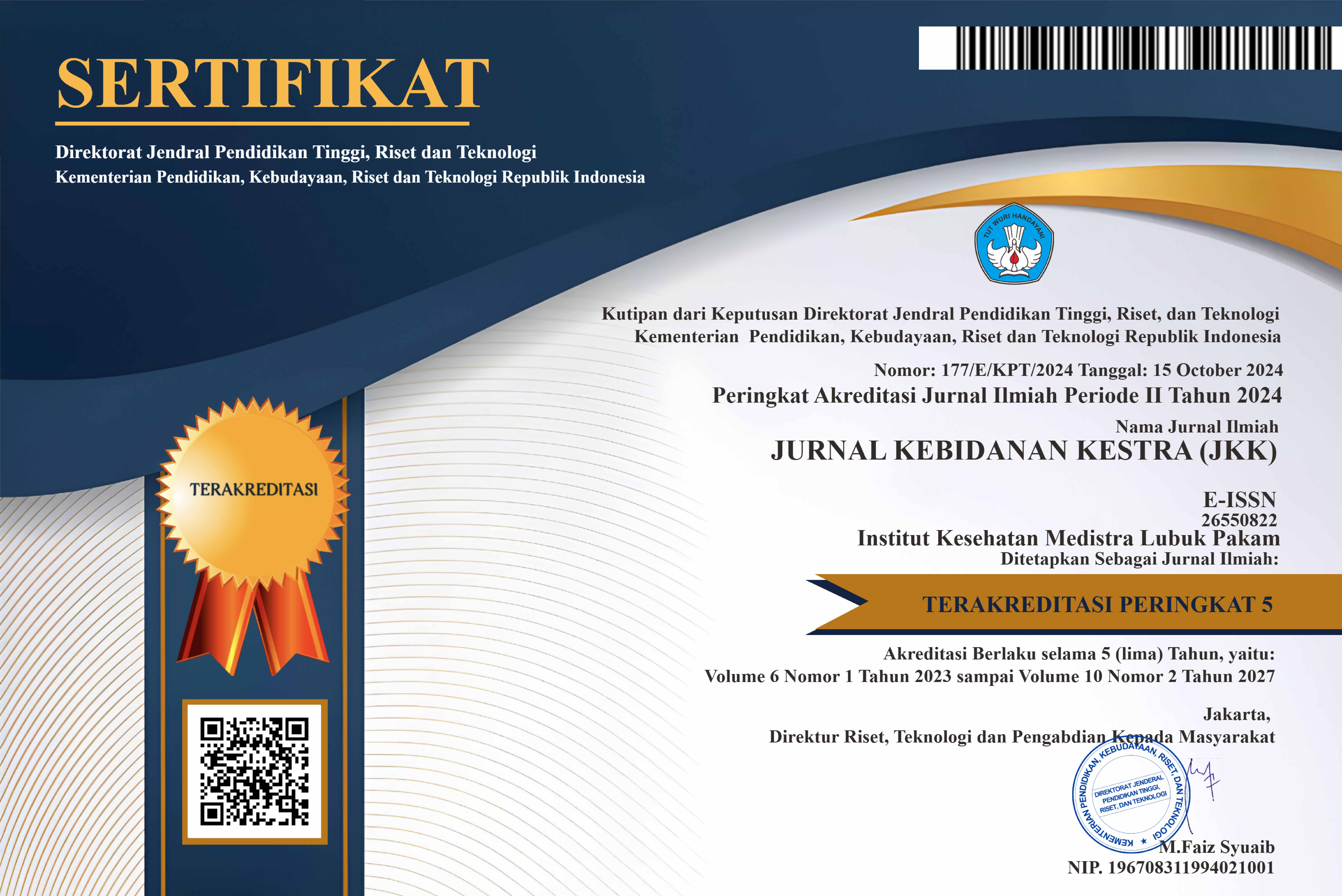The Impact of the Implementation of the Posbindu PTM Program on the Coverage of Early Detection of Non-Communicable Diseases
DOI:
https://doi.org/10.35451/0xmtm732Keywords:
Posbindu, Non-Communicable Diseases, Early Detection, Program ImplementationAbstract
Background: Non-Communicable Diseases (NCDs) are the leading cause of death globally, including in Indonesia, which is experiencing an increasing prevalence of hypertension and diabetes. To address this challenge, the Indonesian government developed the Posbindu PTM program as an early detection effort for NCD risk factors at the community level. However, the effectiveness of the program implementation still faces various challenges in the field. Objective: This study aims to analyze the impact of the Posbindu PTM program implementation on the coverage of early detection of Non-Communicable Diseases in the working area of Merek Health Center, Karo District. Methods: This research employed a quantitative approach with a cross-sectional analytic design. Data were collected from 422 respondents who were active participants of Posbindu PTM using structured questionnaires, observations, and document reviews. Data were analyzed through univariate, bivariate (using Chi-Square tests), and multivariate analysis (using logistic regression). Results: The majority of respondents were female (60.2%) and aged 45–59 years (35.1%). The Posbindu activities were conducted ?3 times per year (68.2%), facilities and infrastructure were adequate (71.3%), cadres' competence was good (64.9%), and health workers’ involvement was high (59.5%). Coverage of blood pressure checks reached 74.4%, Body Mass Index (BMI) measurement 68.0%, random blood sugar checks 62.8%, and education on NCD risk factors 71.1%. A significant relationship was found between the program implementation and early detection coverage. Conclusion: The implementation of the Posbindu PTM program at Merek Health Center was fairly optimal and positively influenced the improvement of early NCD detection coverage. This program plays an important role in empowering communities to prevent and control NCDs through regular screening and health education.
Downloads
References
World Health Organization. (2023). Noncommunicable Diseases. Retrieved from https://www.who.int/news-room/fact-sheets/detail/noncommunicable-diseases
Beaglehole, R., Bonita, R., Horton, R., Adams, C., Alleyne, G., Asaria, P., et al. (2011). Priority actions for the non-communicable disease crisis. The Lancet, 377(9775), 1438-1447.
Kementerian Kesehatan Republik Indonesia. (2018). Laporan Nasional Riskesdas 2018. Jakarta: Badan Penelitian dan Pengembangan Kesehatan.
Kementerian Kesehatan Republik Indonesia. (2016). Pedoman Umum Pos Pembinaan Terpadu Penyakit Tidak Menular (Posbindu PTM). Jakarta: Direktorat Pencegahan dan Pengendalian Penyakit Tidak Menular.
Pusat Data dan Informasi Kementerian Kesehatan Republik Indonesia. (2020). Situasi Penyakit Tidak Menular. Jakarta: Pusdatin Kemenkes RI.
Utami, A. D., & Wulandari, P. (2021). Evaluasi Implementasi Posbindu PTM dalam Upaya Pencegahan Penyakit Tidak Menular. Jurnal Administrasi Kesehatan Indonesia, 9(2), 89–97.
Pratiwi, R., Purnamasari, I., & Astuti, Y. (2020). Faktor yang Berhubungan dengan Keaktifan Posbindu PTM di Wilayah Kerja Puskesmas. Jurnal Kesehatan Masyarakat, 15(1), 45-52.
Yach, D., Hawkes, C., Gould, C. L., & Hofman, K. J. (2004). The Global Burden of Chronic Diseases: Overcoming Impediments to Prevention and Control. JAMA, 291(21), 2616-2622.
United Nations. (2015). Transforming our world: The 2030 Agenda for Sustainable Development. New York: United Nations.
Creswell, J. W. (2014). Research Design: Qualitative, Quantitative, and Mixed Methods Approaches. 4th ed. Thousand Oaks: SAGE Publications.
Setiadi, M. I. (2019). Konsep dan Aplikasi Metodologi Penelitian Kesehatan. Jakarta: Kencana.
Notoatmodjo, S. (2012). Metodologi Penelitian Kesehatan. Jakarta: Rineka Cipta.
Dinas Kesehatan Kabupaten Karo. (2022). Profil Kesehatan Kabupaten Karo 2022. Kabanjahe: Dinkes Karo.
Sugiyono. (2017). Metode Penelitian Kuantitatif, Kualitatif, dan R&D. Bandung: Alfabeta.
Lemeshow, S., et al. (1990). Adequacy of Sample Size in Health Studies. New York: John Wiley & Sons.
Robson, C. (2011). Real World Research: A Resource for Users of Social Research Methods in Applied Settings. 3rd ed. Wiley.
Polit, D. F., & Beck, C. T. (2012). Nursing Research: Generating and Assessing Evidence for Nursing Practice. 9th ed. Philadelphia: Wolters Kluwer Health.
Triola, M. F. (2018). Elementary Statistics. 13th ed. Boston: Pearson.
Hosmer, D. W., & Lemeshow, S. (2000). Applied Logistic Regression. 2nd ed. New York: Wiley.
Emanuel, E. J., et al. (2000). What Makes Clinical Research Ethical? JAMA, 283(20), 2701–2711..
Kusuma, Y. S. (2018). Gender differences in health-seeking behaviour: Insights from a developing country. Social Science & Medicine, 200, 26-34
World Health Organization. (2020). Noncommunicable Diseases Country Profiles 2020. Geneva: WHO.
Nutbeam, D. (2008). The evolving concept of health literacy. Social Science & Medicine, 67(12), 2072-2078.
armer, P. (2017). Pathologies of Power: Health, Human Rights, and the New War on the Poor. University of California Press.
Kementerian Kesehatan Republik Indonesia. (2019). Pedoman Pelaksanaan Posbindu PTM. Jakarta: Kemenkes RI.
Ministry of Health Malaysia. (2018). Guidelines on Non-Communicable Disease (NCD) Screening in Primary Health Care.
Barbero, C., & DeGroff, A. (2019). Role of Community Health Workers in Non-Communicable Disease Screening: A Global Review. Preventing Chronic Disease, 16, E93.
Perry, H. B., & Zulliger, R. (2012). How effective are community health workers? American Journal of Public Health, 102(12), e14–e28.
Mills, K. T., Bundy, J. D., Kelly, T. N., et al. (2016). Global Disparities of Hypertension Prevalence and Control: A Systematic Analysis. Circulation, 134(6), 441–450.
Yusuf, S., Joseph, P., Rangarajan, S., et al. (2020). Modifiable Risk Factors, Cardiovascular Disease, and Mortality in 155,722 Individuals from 21 High-Income, Middle-Income, and Low-Income Countries. The Lancet, 395(10226), 795–808.
GBD 2015 Obesity Collaborators. (2017). Health effects of overweight and obesity in 195 countries. New England Journal of Medicine, 377(1), 13–27.
Wang, Y., & Zhao, L. (2019). Barriers to Diabetes Screening and Management in Developing Countries. Diabetes Research and Clinical Practice, 157, 107864.
Institute for Health Metrics and Evaluation. (2019). Global Burden of Disease Study 2019 Results.
Downloads
Published
Issue
Section
License
Copyright (c) 2025 Reni Aprinawaty Sirait

This work is licensed under a Creative Commons Attribution 4.0 International License.
Copyright in each article is the property of the Author.



























